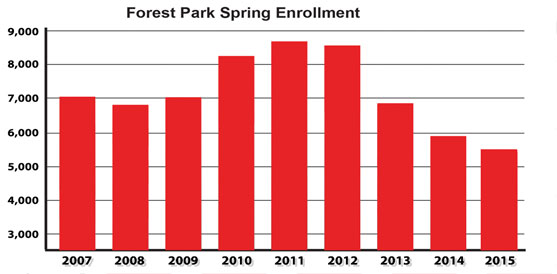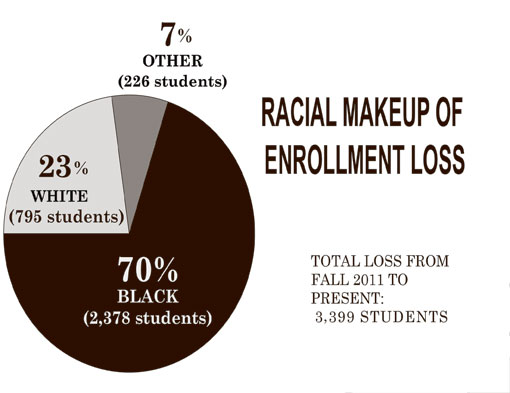
By Jasmine Hsieh
The Scene staff
Enrollment continues to decline at Forest Park, dropping 38 percent in the past 3½ years.
A closer look at statistics reveals another trend.
“The black/African American population has the most significant decrease in enrollment,” said Tracy Hall, vice president of academic affairs.
In the past 10 years, overall enrollment peaked in the fall of 2011 with 8,823 students. This spring, it’s down to 5,424 students, a difference of 3,399 students.
During the same period, black enrollment went from 4,945 to 2,567 students, a loss of 2,378 students, so 70 percent of the 3,399 students lost were black.
Hall identified changes in financial aid as the most significant factor for the overall decline. In the past, college students could receive federal Pell grants for nine years. That has been tightened to six years.

“We have a large percentage of students (at Forest Park) who are Pell-grant eligible,” Hall said.
The college also has revised the degree-audit system and its financial-aid policy.
“A few years ago, students could take whatever classes they wanted with financial aid,” said Scott Queener, counseling department chair. “But now, the financial aid only pays for classes that build towards the student’s major.”
Forest Park isn’t alone with its enrollment problem. It’s occurring on all St. Louis Community College campuses.
So far, no full-time employees have lost their jobs, according to Chancellor Dennis Michaelis.
“But when you’ve gone from 30,000 students to under 20,000 students, there are going to be some drastic changes as far as the financial structure of the institution,” he said. “Difficult decisions are going to have to be made.”

More reasons for decline
Beyond black enrollment, other groups with higher-than-average declines at Forest Park are traditional full-time freshmen from the city of St. Louis, 26- to 50-year-olds and non-degree-seeking students.
Colleges across the country have seen drops in enrollment of 17- and 18-year-old students. In St. Louis, fewer students are graduating high school each year, shrinking the pool of potential freshmen.
“This is one of the reasons for enrollment decline that has been discussed nationally,” Hall said.
Also, community college enrollments tend to drop nationally when the economy improves. People are getting or keeping jobs instead of losing jobs and returning to school for retraining.
“Community college enrollment is anti-cyclical with the economy,” said James Munden, math department chair at Forest Park.
“(After) the economy soured in 2008, we saw huge bumps in enrollment in 2009, 2010 and 2011. But the economy has improved substantially. Enrollment is going down again as more people are getting jobs without degrees.”

Hall also identified the Affordable Care Act, better known as “Obamacare,” as another possibly negative factor related to college enrollment.
Prior to that law’s enactment in 2010, people who had graduated from high school and were under 24 years old had to be full-time college students to remain on their parents’ health-insurance policies.
Today, children can remain on their parents’ policies until age 26, even if they’re not in college.
“That’s another reason, which I’ve heard discussion about, why people stopped going to college, because they would still get health insurance,” Hall said.
Queener even speculates that some Forest Park students may have dropped out because of Metro’s recent decision to stop allowing students 24 and older to buy discounted bus passes.
College works to solve problem
Declining enrollment was the main topic in Forest Park opening sessions this semester. These are faculty meetings held a week before classes start.
Faculty broke into small groups to brainstorm about possible solutions.
“Now that we know what the problems are, we plan to have follow-up conversations on how we can implement those ideas,” Hall said.
Hall is working on strengthening partnerships between the college and K-12 schools, expanding the college’s presence in the community and offering more online courses.
“Federal financial aid is pretty much what it is,” she said. “So how do we address that and make sure we have the right program, at the right time, in the right format, to reach students’ needs?
We’re working on that in all aspects of the college.”
Enrollment decreases affect some departments more than others.
Most college students are required to take math classes for their degrees. So when Forest Park head counts go from 8,823 to 5,424, that means the math department loses more than 3,000 students.

“We are so heavily impacted by the enrollment decline that we have to drastically reduce the sections that we offer, especially for developmental math courses,” Munden said.
The math department is looking into more cost-effective ways to offer classes.
“For example, we are investigating open-source materials, so students wouldn’t have to purchase textbooks for math courses,” Munden said.
The math department also is working on instituting more self-paced math courses, as many students seem to enjoy those courses more than traditional lecture courses.
“We are also trying to make sure that students are enrolled in the right classes,” Munden said. “For example, we have alternative college algebra classes designed for non-STEM students. We encourage students to talk to advisers, faculty members, and myself.”
Two Forest Park counselors, Kathleen Swyers and Bella Hafezi, are experimenting with a case-management model.
Today, most students aren’t assigned to specific counselors. They can request someone but otherwise are paired with whoever is available at the time.
“But now (Swyer and Hafezi) are assigned to a number of students,” Queener said. “They keep track of the students, check in on them and see how they are doing. And we are piloting the model to see (what) the students and counselors think of its effectiveness.”
If the model works well, the counseling center may expand it to serve more students to help with enrollment and retention.
“We are also trying to set up more information tables (and) passing out more brochures throughout the campus to promote our services,” Queener said.
